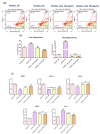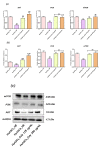Calystegines Improve the Metabolic Activity of Human Adipose Derived Stromal Stem Cells (ASCs) under Hyperglycaemic Condition through the Reduction of Oxidative/ER Stress, Inflammation, and the Promotion of the AKT/PI3K/mTOR Pathway
- PMID: 35327652
- PMCID: PMC8946193
- DOI: 10.3390/biom12030460
Calystegines Improve the Metabolic Activity of Human Adipose Derived Stromal Stem Cells (ASCs) under Hyperglycaemic Condition through the Reduction of Oxidative/ER Stress, Inflammation, and the Promotion of the AKT/PI3K/mTOR Pathway
Abstract
Hyperglycaemia and its resulting glucotoxicity are among the most prominent hallmarks of diabetes mellitus (DM) development. Persistent hyperglycaemia further leads to oxidative stress via mitochondrial dysfunction and subsequent ER stress onset, while associated hyperlipidaemia triggers the adipose tissue to secrete pro-inflammatory cytokines. In this study, the effect of calystegines has been investigated in an experimental model of hyperglycaemia induced on human ASCs cells. Different cellular pathways including apoptosis, oxidative and ER stress, inflammation as well as Pi3K/AKT/mTOR metabolic-associated axis have been evaluated by means on RT-qPCR, western blot, and flow cytometry techniques. Treatment of HuASCs cells with calystegines strongly promoted the hyperglycaemic cells survival and significantly diminished oxidative stress, mitochondrial dynamics failure and ER stress, while improving the endogenous cellular antioxidant defenses. Interestingly, nortropane alkaloids efficiently prevented the hyperglycaemia-mediated inflammatory response, as evidenced by the regulation of the pro- and anti-inflammatory response in HuASCs cells. Finally, we evidenced that calystegines may exert their protective effect on HuASCs cells metabolic functions through the restoration of the defective PI3K/AKT/mTOR pathway. Overall, the present investigation demonstrated that calystegines possess important abilities to protect HuASCs against hyperglycaemia-induced cellular dysfunction, and it evidenced that the observed effects are associated to the promotion of PI3K/AKT/mTOR pathway.
Keywords: ER stress; HuASCs; calystegines; hyperglycaemia; inflammation; mTOR.
Conflict of interest statement
The authors declare no conflict of interest.
Figures













Similar articles
-
Hyoscyamus albus nortropane alkaloids reduce hyperglycemia and hyperinsulinemia induced in HepG2 cells through the regulation of SIRT1/NF-kB/JNK pathway.Cell Commun Signal. 2021 May 25;19(1):61. doi: 10.1186/s12964-021-00735-w. Cell Commun Signal. 2021. PMID: 34034759 Free PMC article.
-
Nintedanib Ameliorates Bleomycin-Induced Pulmonary Fibrosis, Inflammation, Apoptosis, and Oxidative Stress by Modulating PI3K/Akt/mTOR Pathway in Mice.Inflammation. 2023 Aug;46(4):1531-1542. doi: 10.1007/s10753-023-01825-2. Epub 2023 May 9. Inflammation. 2023. PMID: 37160579 Free PMC article.
-
The Combination Treatment of Curcumin and Probucol Protects Chondrocytes from TNF-α Induced Inflammation by Enhancing Autophagy and Reducing Apoptosis via the PI3K-Akt-mTOR Pathway.Oxid Med Cell Longev. 2021 Jun 24;2021:5558066. doi: 10.1155/2021/5558066. eCollection 2021. Oxid Med Cell Longev. 2021. PMID: 34257809 Free PMC article.
-
[Recent studies on PI3K/AKT/mTOR signaling pathway in hematopoietic stem cells].Zhongguo Shi Yan Xue Ye Xue Za Zhi. 2013 Feb;21(1):245-9. doi: 10.7534/j.issn.1009-2137.2013.01.050. Zhongguo Shi Yan Xue Ye Xue Za Zhi. 2013. PMID: 23484729 Review. Chinese.
-
Extracellular Vesicles from Adipose Tissue Could Promote Metabolic Adaptation through PI3K/Akt/mTOR.Cells. 2022 Jun 3;11(11):1831. doi: 10.3390/cells11111831. Cells. 2022. PMID: 35681526 Free PMC article. Review.
Cited by
-
Monocyte CCL2 signaling possibly contributes to increased asthma susceptibility in type 2 diabetes.Sci Rep. 2025 Mar 28;15(1):10768. doi: 10.1038/s41598-025-95039-1. Sci Rep. 2025. PMID: 40155667 Free PMC article.
-
Atractylodin and β-eudesmol from Atractylodes lancea (Thunb.) DC. Inhibit Cholangiocarcinoma Cell Proliferation by Downregulating the Notch Signaling Pathway.Asian Pac J Cancer Prev. 2023 Feb 1;24(2):551-558. doi: 10.31557/APJCP.2023.24.2.551. Asian Pac J Cancer Prev. 2023. PMID: 36853304 Free PMC article.
-
Retinal Microenvironment-Protected Rhein-GFFYE Nanofibers Attenuate Retinal Ischemia-Reperfusion Injury via Inhibiting Oxidative Stress and Regulating Microglial/Macrophage M1/M2 Polarization.Adv Sci (Weinh). 2023 Oct;10(30):e2302909. doi: 10.1002/advs.202302909. Epub 2023 Aug 31. Adv Sci (Weinh). 2023. PMID: 37653617 Free PMC article.
References
MeSH terms
Substances
LinkOut - more resources
Full Text Sources
Medical
Miscellaneous

